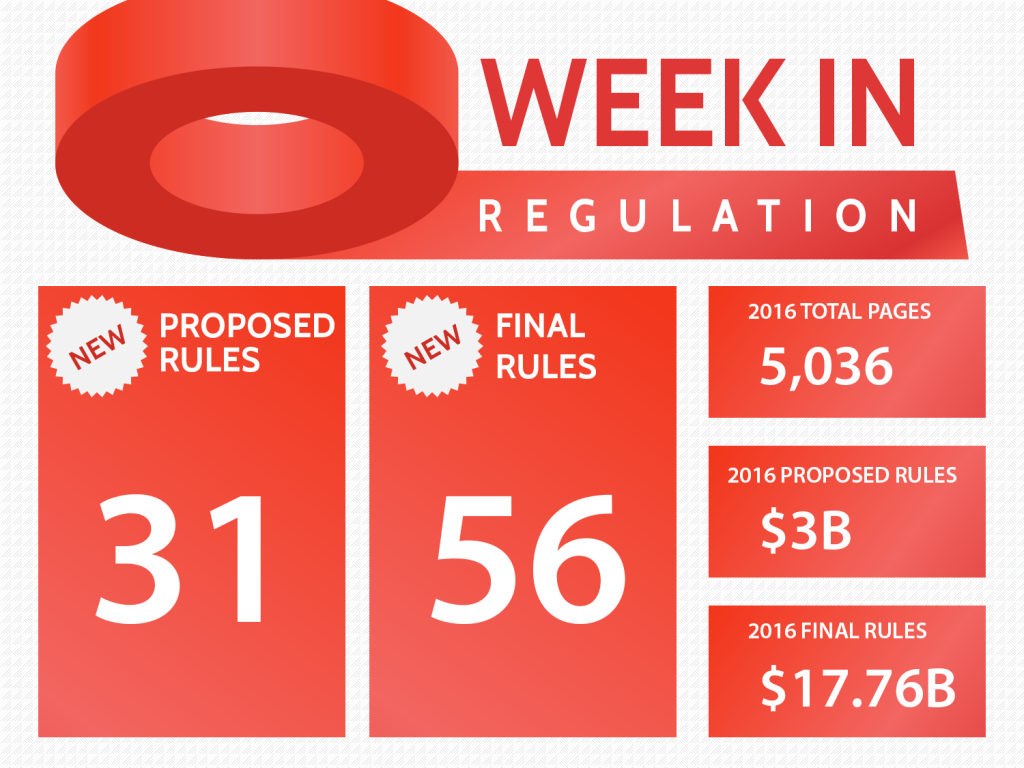Week in Regulation
February 1, 2016
$341 Million in Regulatory Costs

The snow-filled streets of the nation’s capital did slow regulatory output later in the week, as the federal government was officially closed on Monday and Tuesday. However, regulators still managed to publish more than $340 million in burdens; annualized costs were just $28 million, compared to $175 million in benefits. Paperwork grew by more than 315,000 hours. A Department of Energy (DOE) efficiency rule for pumps led the week. The per capita regulatory burden for 2016 is $64.
Regulatory Toplines
- New Proposed Rules: 31
- New Final Rules: 56
- 2016 Total Pages of Regulation: 5,036
- 2016 Final Rules: $17.76 Billion
- 2016 Proposed Rules: $3 Billion
The American Action Forum (AAF) has catalogued regulations according to their codification in the Code of Federal Regulations (CFR). The CFR is organized into 50 titles, with each title corresponding to an industry or part of government. This snapshot will help to determine which sectors of the economy receive the highest number of regulatory actions.

DOE finalized its efficiency rule for pumps. Total costs, during a 30-year period are $300 million, but annualized costs are just $17 million, virtually unchanged from the proposed version; annual benefits are $91 million. DOE estimates the average price of industrial pumps could increase by $46.
The Department of Labor (DOL) published a proposal to promote nondiscrimination and equal opportunity in the workforce. The measure includes new language that “replaces ‘he or she’ with ‘the individual,’ ‘person,’ or other appropriate identifier wherever possible to avoid the gender binary,” among other provisions. The proposal adds $28 million in first year costs, followed by close to $10 million in ongoing annual burdens. Paperwork is the largest component, with more than 315,000 annual paperwork burden hours.
Affordable Care Act
Since passage, based on total lifetime costs of the regulations, the Affordable Care Act has imposed costs of $49.9 billion in state and private-sector burdens and 175.1 million annual paperwork hours.
Dodd-Frank
Click here to view the total estimated revised costs from Dodd-Frank; since passage, the legislation has produced more than 76.6 million paperwork burden hours and imposed $39.3 billion in direct compliance costs.
A Note on Paperwork
The Office of Management and Budget approved 43 paperwork requirements, decreasing the paperwork burden hours by 3,415,404 hours. There were two major changes to existing paperwork requirements (defined as an hourly burden increase or decrease of 500,000 or greater).
The largest increase in paperwork burden hours imposed by an information collection requirement (ICR) was 3,464,739 hours from the Social Security Administration. The largest decrease in paperwork burden hours imposed by an ICR was 26,500 hours from the Federal Reserve.
Total Burdens
Since January 1, the federal government has published $20.7 billion in compliance costs ($17.76 billion in final rules) and has imposed 907,000 net paperwork burden hours (470,000 from final rules). Click below for the latest Reg Rodeo findings.











